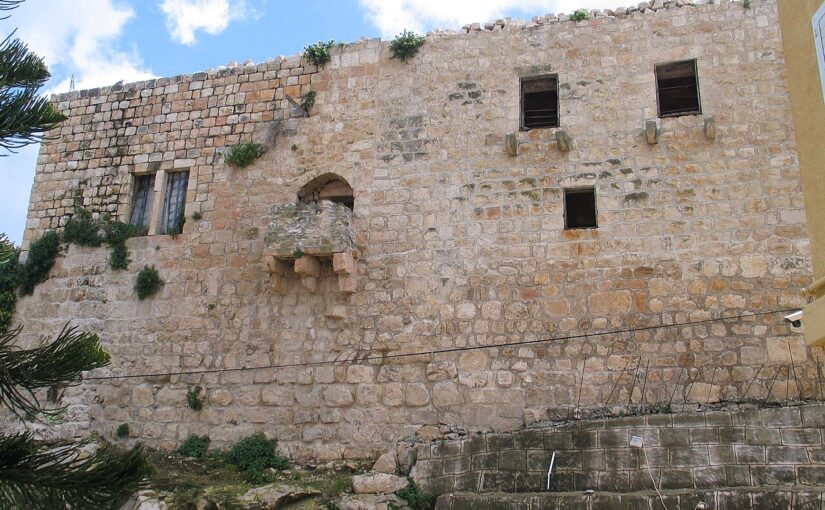In the Western Upper Galilee, the village of Mi’ilya climbs a sunlit hill, enveloped by olive groves, vineyards, and a tapestry of green valleys. Views stretch toward Mount Meron and Hermon in the distance, while narrow lanes weave between stone houses. The air is scented with wild herbs and the soft hum of daily life. Mi’ilya’s atmosphere is peaceful yet vibrant, shaped by centuries of history and the rhythms of the land. Few places in Israel blend natural beauty with such deep cultural roots, and atop this hill stands Castellum Regis, the King’s Castle, a Crusader fortress that continues to watch over its village even as time transforms stone and story.
A Castle Born of Kings and Knights
The origins of Castellum Regis trace back to the twelfth century, when the Crusader King Baldwin III ordered the construction of a stronghold on Mi’ilya’s highest ridge. He envisioned a fortress that would safeguard the strategic route between Acre and Damascus and anchor royal power in the region. Castellum Regis soon became a hub for defense, administration, and the control of agricultural estates.
After Baldwin’s reign, the castle passed to the noble De Milly family. Their name still echoes in the village’s title and local memory. By the thirteenth century, Castellum Regis had transformed from a royal outpost to the beating heart of a feudal estate. The De Millys expanded their holdings, and Mi’ilya became a center for farming, trade, and diplomacy. Its walls held not only knights and arms but also treasures, archives, and the daily commerce of a thriving rural community.
Military Strength and Cultural Flourish
The castle’s square layout and formidable bastions reflected its defensive purpose, guarding the King’s interests and the surrounding villages. Its location, high above the valley floor, allowed residents to spot approaching armies and command the countryside. Within these walls, Crusader society unfolded, a mix of Latin Christians, local villagers, monks, and merchants.
Yet Castellum Regis was more than a military bulwark. It became a symbol of feudal stability and cultural exchange. The local population grew with settlers from the Latin West and indigenous Levantine families. Churches and homes were built using Crusader stonework, and agricultural terraces radiated outward from the fortress, shaping the land and economy. In Mi’ilya, the rhythms of medieval village life, prayers, feasts, family gatherings, blended with the responsibilities of defending the kingdom.
The castle saw its share of conflict, enduring Mamluk sieges and changing hands between Crusader, Muslim, and later European rulers. Saladin’s armies captured Mi’ilya after the decisive battle at the Horns of Hattin in 1187, but it was soon restored to the Crusaders through a rare peace treaty in 1192. Later, in the 13th century, the site was sold to the Teutonic Order before their headquarters moved to nearby Montfort Castle.
Living History in the Present
Though the castle fell to ruin under the Mamluks in 1265, Mi’ilya never lost its connection to the past. Stone walls and arches survive, echoing the days when kings and knights walked the ramparts. Underneath the village, archaeologists have discovered one of the largest Crusader-era wine cellars ever found, pointing to the region’s agricultural prosperity and connection to Mediterranean trade. Roman columns from earlier eras stand outside the village church, while Byzantine mosaics remain hidden under local homes.
Today, Mi’ilya’s residents carry forward both faith and tradition. The village is one of Israel’s few exclusively Christian towns, with a strong Melkite Greek Catholic identity and a spirit of hospitality. Families have lived here for generations, often in houses built atop Crusader stones. The Chateau du Roi, a restaurant now housed in part of the old fortress, invites guests to dine beside original medieval architecture and sample local Galilean flavors. Here, visitors experience not only great food but also the warmth and stories of a community rooted in its past.
The village’s festivals, music, and shared meals blend Crusader history with contemporary culture. Throughout the year, Mi’ilya welcomes travelers who seek both spiritual meaning and a sense of continuity with centuries of change.
The Lasting Legacy and Why Visit
Castellum Regis is more than an ancient ruin; it is a living chapter in the story of the Galilee. The King’s Castle stands as a testament to resilience, adaptation, and the enduring bonds between land and people. Medieval fortifications rise beside vibrant homes, and every stone carries a memory of faith, fortitude, and transformation.
Mi’ilya offers travelers what few sites can, a tangible connection to the Crusader world and a warm invitation into local lives. Visiting the castle and village, one finds the allure of dramatic landscapes, the delight of historical discovery, and the friendship of a proud community. Whether wandering ancient passages, savoring a Galilean meal, or celebrating in the village square, each experience weaves together the story of kings, knights, families, and faith.
To stand at Castellum Regis is to join a journey that began nearly nine hundred years ago and continues through every day in this extraordinary corner of the Galilee.
Image by Bukvoed.
If our work has inspired you, helped you grow, or simply brought a little warmth to your day, consider supporting Thalysia.com with a small donation. Your contribution helps us continue exploring ancient landscapes, documenting local traditions, and celebrating the art of living well.
